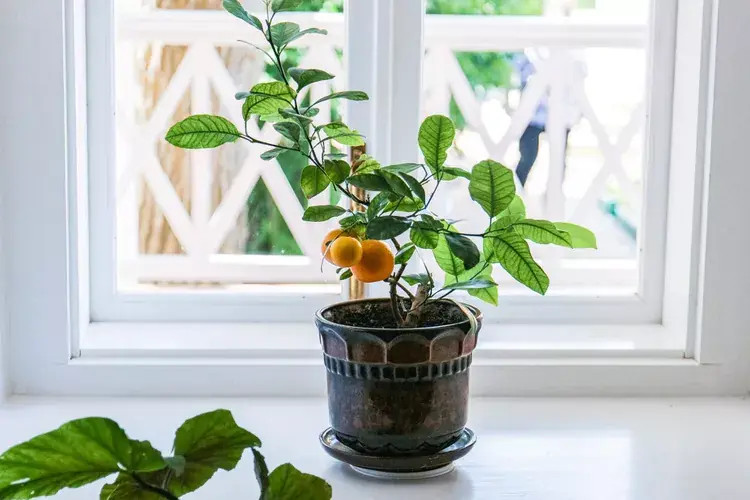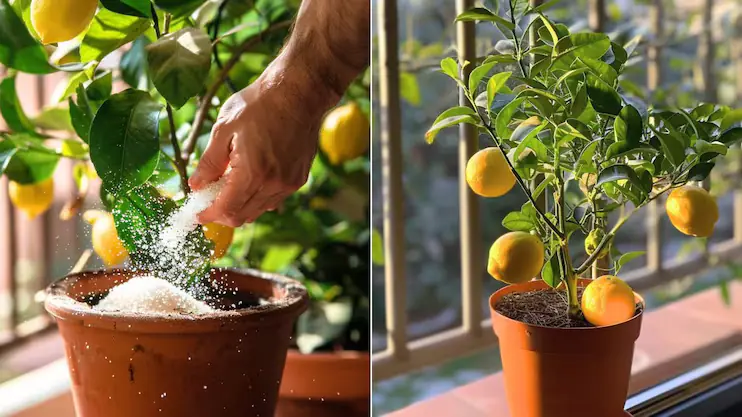
How to Grow a Lemon Tree From Seed Indoors or Outside, According to Horticulturists
When life hands you lemon seeds, plant a lemon tree. Although it can be a labor of love, it is possible to grow a fruit-producing citrus tree from seed indoors or outside in USDA hardiness zones 9 to 11. Generally, it takes seven to 15 years for a lemon tree planted from seed to mature and produce fruit. In the meantime, you can enjoy this plant's beautiful foliage. If you're in it for the long haul, these expert tips for growing a lemon tree from seed will help you produce a healthy, fruit-bearing tree before you know it.
- Justine Kandra, horticulturist at Missouri Botanical Garden's Kemper Center for Home Gardening
- Steven Biggs, horticulturist and author of Grow Lemons Where You Think You Can't
How to Plant Lemon Seeds
Planting lemon seeds is easy to do with citrus purchased from the grocery store or farmers market. Keep in mind that the seedlings will look similar to the parent plant but not identical.
Choose a Lemon
Seeds from any healthy, mature lemon fruit can be used to grow a lemon tree, says Justine Kandra, a horticulturist at Missouri Botanical Garden's Kemper Center for Home Gardening. Check for signs of rotting or bruising when selecting a lemon to harvest the seeds from.
Remove the Seeds
Cut the lemon in half, being careful not to accidentally slice open the seeds. Gently remove the seeds from the fruit and rinse them off with water to remove any pulp and lingering sugars.
Plant the Seeds
Fill a small pot or plug tray with fertilizer-free potting soil. Plant the seeds 1-inch deep in the soil. "It is best to plant the seeds as soon as possible, because they do not tolerate being dried out for too long," says Kandra.
Provide the Right Conditions
Water the seeds thoroughly and keep them in a brightly lit, warm area (at least 70 degrees Fahrenheit) to allow them to germinate. If you don't have a space with adequate sunlight, supplement with grow lights. After a few weeks, the seeds will begin to sprout.
Types of Lemons
Consider these popular cultivars when choosing a type of lemon to grow from seed.
Meyer Lemon
This hybrid of citron and a mandarin orange is not considered a true lemon. Meyer lemons are smaller, more round, and taste sweeter than the traditional lemon. The flavor is more herbal than it is fruity.1
Lisbon Lemon
Often used to make lemonade, Lisbon lemons are the most commonly sold type in the Eastern U.S. They have a distinctive lemon shape with a pushed-in point on one end. As the name implies, Lisbon lemons are believed to have originated in Portugal.1
Eureka Lemon
Eureka lemons are similar to Lisbon lemons in flavor and aroma. Some Eureka Lemon trees feature beautiful white-and-green variegated leaves, filling your home or garden with beauty even when they're not producing fruit. The lemons have pink pulp sacks, giving the flesh a pinkish hue.1
How to Care for Lemon Trees
Whether you are growing lemon trees indoors or outside, the requirements needed to ensure they grow and thrive are similar.
Sunlight
Your lemon tree will need at least eight hours of full sun each day, says horticulturist Steven Biggs. It will grow best indoors if it has access to a south-facing, sunny window. As mentioned, you can use grow lights to supplement natural light if necessary.
Soil
Lemon trees need well-draining soil. If planting outdoors, choose a location that doesn't pool with water during heavy rains. When planting in containers, choose a well-draining potting mix or amend potting mix with pumice or perlite to improve drainage.
Water
Make sure the soil stays evenly moist, but not waterlogged. For best success, water your lemon tree once the soil has mostly dried out before watering again, says Biggs.
Fertilizer
Apply an all-purpose fertilizer with micronutrients or a lemon tree-specific fertilizer during the growing season to encourage fruit production. Our experts recommend following the manufacturer's directions for guidance on how and how often to apply the fertilizer.
How to Repot Lemon Trees

Young lemon trees grown in containers will need to be repotted about every two years; mature ones should be repotted every three to four years. The best time to do so is in the spring, right ahead of the growing season, says Kandra. Here's how to do it:
- Gently remove the lemon tree from its original container.
- Fill a new container halfway with well-draining potting soil. The new container should be 1 to 2 inches wider in diameter than the original.
- Place the lemon tree in the new container and backfill with soil.
- Water the soil thoroughly and place the container in a brightly lit, warm location.
How to Harvest Lemons From a Lemon Tree
Lemons that are ready to be picked are firm and bright yellow—you should be able to easily take them off the plant. Using your hands, gently twist the fruit and pull it off the tree. Lemons will stay ripe for weeks to months on a tree, so you don’t have to worry about them going bad quickly, says Biggs.
Note
Although it takes about seven to 15 years to grow a lemon tree from seed, it will be worth it once you start to see fruit form. Biggs said he had nearly 50 lemons on his tree ahead of a recent harvest.
Common Problems With Lemon Trees
Although lemon trees are relatively low-maintenance, there are some common issues you may run into when growing and caring for this plant.
Pests
Mealy bugs, spider mites, and scale insects are common lemon tree pests. The best way to get rid of them is by dabbing the infested foliage with a cotton round and rubbing alcohol, says Biggs. He recommends growing your lemon tree in humid conditions, since these bugs don't survive in this type of environment.
Root Rot
If your lemon tree has root rot, it is likely due to poor drainage. Make sure you plant an outdoor lemon tree in a well-draining location. If you planted the tree in a container indoors, make sure it has drainage holes. Overwatering may also cause root rot, so be sure to feel the soil for dryness before watering. If scaling back your watering schedule doesn't work, you may need to repot the tree.
News in the same category


My Wedding Planner Sent Me Photos of a Venue—But It Wasn’t the One I Booked… or Even In My City

When a husband, ignoring his wife’s opinion, took his relatives’ side

You came here with nothing, and you’ll leave the same way — together with your whole family!” I told him. But I had no idea just how cruelly my prophecy would come true

The Bridge Beneath the Willow

Ember’s Last Melody

Good thing you became the heir to that apartment downtown—I’ll be living in it, since I gave mine to my daughter,” her mother-in-law announced.

When your son buys his own summer house, then you can come for the summer. Until then, you’re not expected here,” Dasha declared to her mother-in-law

If you don’t like my mother, then leave!” the husband declared, not expecting his wife to actually do it

I hid the truth about my business and income from my fiancé and his family, and at a family dinner they found out the truth

I found out my husband was mocking me in front of his friends—so I decided to teach him a lesson he won’t forget

You mean nothing to me,” my husband said — he had no idea he’d be in my office the next day begging for a job

I won’t take her in—I’m too busy for a sick old woman,” Nikita declared coldly

A Daughter’s Betrayal: The Fight for My Dignity

My ex said, ‘We’ve got nowhere to live with my new wife, let us stay at your summer house.’ I let them in… then I called the police and filed a report for breaking and entering

I went to the clinic to visit my mother-in-law and saw my husband signing unusual documents

“Katya, has Sasha told you yet?” the mother-in-law rattled off. “Listen! There will be forty people. So we’ll start cooking at night. I’ll come ahead of time, at six in the evening the day before.”

When family neglect becomes a turning point: a daughter’s journey to success and self-worth

The Cat Who Helped Us Remember Love

The Dog Who Kept Grandpa Walking
News Post

My Baby Monitor Showed a Woman in My Living Room—But My House Was Completely Empty

My Wedding Planner Sent Me Photos of a Venue—But It Wasn’t the One I Booked… or Even In My City

When a husband, ignoring his wife’s opinion, took his relatives’ side

You came here with nothing, and you’ll leave the same way — together with your whole family!” I told him. But I had no idea just how cruelly my prophecy would come true

The Bridge Beneath the Willow

Ember’s Last Melody

Good thing you became the heir to that apartment downtown—I’ll be living in it, since I gave mine to my daughter,” her mother-in-law announced.

When your son buys his own summer house, then you can come for the summer. Until then, you’re not expected here,” Dasha declared to her mother-in-law

Bibimbap (Korean Mixed Rice)

Mango Sticky Rice

Roasted Chicken Drumsticks with Potatoes & Fresh Salad

If you don’t like my mother, then leave!” the husband declared, not expecting his wife to actually do it

I hid the truth about my business and income from my fiancé and his family, and at a family dinner they found out the truth

Amazing effects of papaya seeds you may not know

Succulent Herb Butter Beef Tenderloin Roas

I found out my husband was mocking me in front of his friends—so I decided to teach him a lesson he won’t forget

You mean nothing to me,” my husband said — he had no idea he’d be in my office the next day begging for a job

I won’t take her in—I’m too busy for a sick old woman,” Nikita declared coldly

A Daughter’s Betrayal: The Fight for My Dignity
